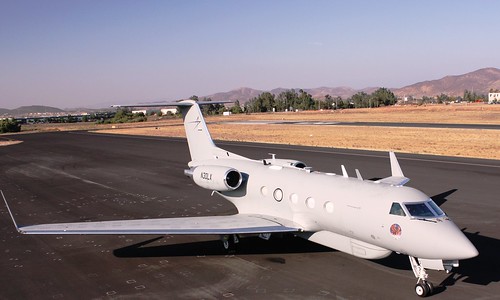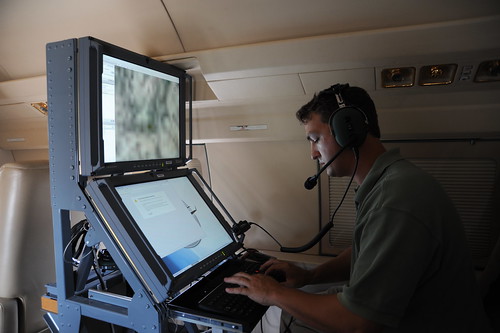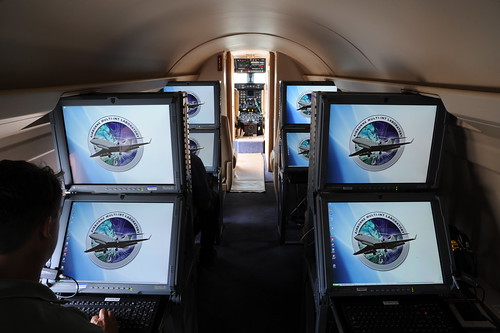I’m absolutely fascinated about this video. In 2009 James May, presenter of UK TV series “Top Gear”, took a ride in a USAF Lockheed U-2 (TU-2S two-seat trainer) – they reached an altitude of 70000 feet. If you’re an aviation buff (and I know you are) you definitly have to watch this.
Category: Lockheed Martin
NASA Sponsors Advanced Aircraft Concepts Study
Last week NASA has awarded two contracts for studies designed to identify advanced concepts for commercial airliners that could enter service in 2025. Main goal of the new airliners is that they need to be quieter, greener and more fuel-efficient.
Lockheed Martin (Skunk Works) was selected for a contract worth $2.99 million.
Northrop Grumman was selected for a contract worth $2.65 million.
Both teams will define a preferred system concept for an aircraft that can fly up to 85 percent of the speed of sound; cover a range of approximately 7,000 miles; and carry between 50,000 and 100,000 pounds of payload, either passengers or cargo.
Both contracts have a performance period of 12 months, beginning in November.
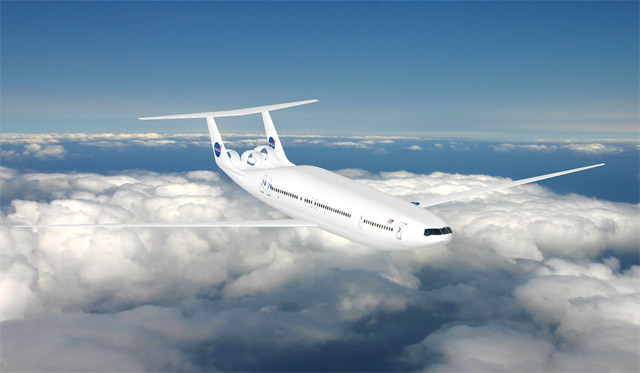
The NASA project is working to develop technology that would enable future aircraft to burn 50 percent less fuel than current models; reduce harmful emissions by 50 percent; and shrink the geographic areas affected by objectionable airport noise by 83 percent.
Earlier this year MIT already presented its own vision of future commercial planes to NASA. This research contract was sponsored by NASA with $2.1 million.
Source: NASA
Image: MIT/Aurora Flight Sciences
Lockheed Martin HC-130J Takes First Flight
The new Lockheed Martin HC-130J personnel recovery aircraft took off for the first time on July 29. Due for delivery to the U.S. Air Force’s Air Combat Command in September 2010, the HC-130J is scheduled to reach initial operational capability in 2012. An Air Force Special Operations Command MC-130J variant of this aircraft will fly in early 2011.
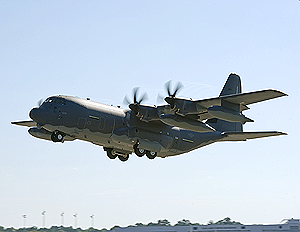 Compared to a classic C-130 a new propulsion system, featuring four powerful Allison AE2100D3 engines, generates more thrust while increasing fuel efficiency. An all-composite six-blade Dowty Aerospace R391 propeller system is lighter in weight and has fewer moving parts. Advanced avionics includes LCD instrument readouts for aircraft flight control, operating systems, and navigation. Besides two head-up displays, it has four multi-functional head-down LCD displays which are night vision goggles compatible. Two mission computers and two backup bus interface units provide dual redundancy. In the baseline (airlifter) version the avionics upgrades result in reduction of crew to 2 pilots and 1 loadmaster – no flight engineer, navigator or radio operator is needed in the cockpit anymore.
Compared to a classic C-130 a new propulsion system, featuring four powerful Allison AE2100D3 engines, generates more thrust while increasing fuel efficiency. An all-composite six-blade Dowty Aerospace R391 propeller system is lighter in weight and has fewer moving parts. Advanced avionics includes LCD instrument readouts for aircraft flight control, operating systems, and navigation. Besides two head-up displays, it has four multi-functional head-down LCD displays which are night vision goggles compatible. Two mission computers and two backup bus interface units provide dual redundancy. In the baseline (airlifter) version the avionics upgrades result in reduction of crew to 2 pilots and 1 loadmaster – no flight engineer, navigator or radio operator is needed in the cockpit anymore.
The extensive modifications also feature a belly-mounted 360-degree surface search radar, Direction Finder system, nose-mounted electro-optical/infrared radar, FLIR, an airborne Automatic Identification System and new communication systems.
The HC-130J furthermore offers external fuel tanks, flare/smoke float launch tubes and the USAF-standard liquid oxygen system has been converted to gaseous O2.
Source: Lockheed Martin
Photo: Lockheed Martin
First USAF HC-130J Combat Rescue Tanker Rolls Out
Lockheed Martin rolled out the first of a new fleet of HC-130J combat rescue tankers for the U.S. Air Force’s Air Combat Command (ACC)
Lockheed Martin is contracted with the U.S. Air Force to build 21 C 130J Super Hercules to replace aging fleets of combat search and rescue HC-130s and special operations MC 130s. The U.S. Air Force is authorized to acquire up to 31 HC/MC 130Js (11 HCs and 20 MCs).

The new aircraft, which is based on a KC-130J tanker baseline, will have the Enhanced Service Life Wing, Enhanced Cargo Handling System, a Universal Aerial Refueling Receptacle Slipway Installation (boom refueling receptacle), an electro-optical/infrared sensor, a combat systems operator station on the flight deck, and provisions for the large aircraft infrared countermeasures system.
Photo & Source: Lockheed Martin
Video – F-35B STOVL Flight
Lockheed Martin released a video of the first Lockheed Martin F-35B Lightning II stealth fighter, passing overhead at 40 knots (46 mph) prior to a slow landing at Naval Air Station Patuxent River, Md. The flight was one of the last missions before the aircraft’s first vertical landing, and confirmed the jet’s power and controllability at very low speeds. The aircraft’s short takeoff/vertical landing (STOVL) propulsion system generates more than 41,000 pounds of vertical thrust, and enables airspeeds from zero to Mach 1.6. The F-35B will be flown by the United States Marine Corps, the United Kingdom’s Royal Air Force and Royal Navy, and the Italian Air Force and Navy. It will be capable of operating from small ships and austere bases near front-line combat zones.
Video
Photo
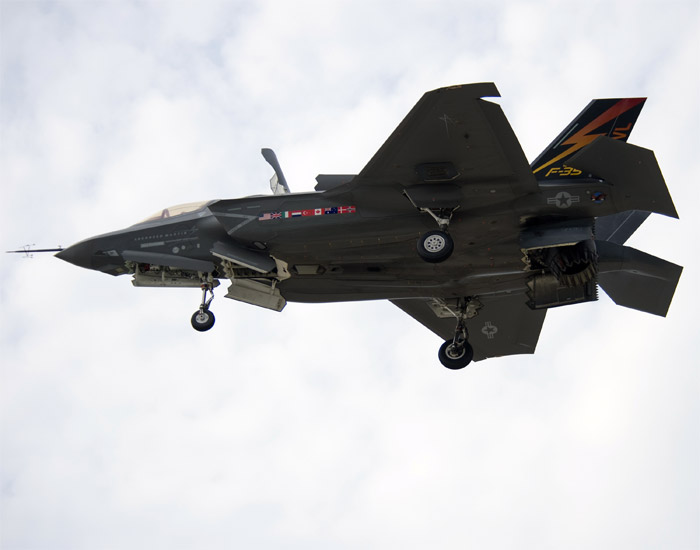
C-5M Super Galaxy Sets 41 World Records
A joint U.S. Air Force and Lockheed Martin flight crew flying a C-5M Super Galaxy strategic transport claimed 41 world aeronautical records in one flight on September 13.
The flight from Dover AFB broke eight existing world marks and established standards in 33 other categories where there had been no previous record attempt. The records were set in the Class C-1.S, Jet category for altitude in horizontal flight, altitude with payload, time-to-climb, time-to-climb with payload and greatest payload to 2,000 meters. The aircraft carried a payload of more than 80,000 kg (the actual measured payload weight was 176,610 lb) to an altitude of more than 41,100 feet in 23 minutes, 59 seconds.
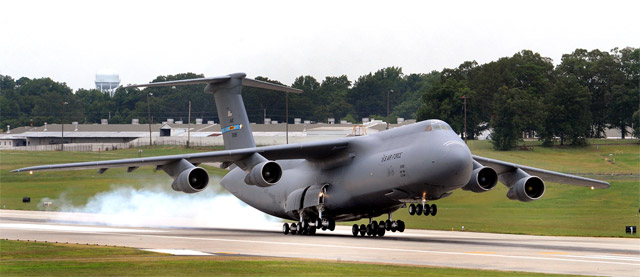
The Class C-1.S Jet category is for aircraft weighing from 250,000 kilograms (551,155 pounds) to 300,000 kg (661,386 lb). The C-5M had a takeoff weight of 649,680 lb, which included fuel, crew weight, necessary equipment, and the payload, which was loaded on 29 standard U.S. military 463L cargo pallets. All C-5s are capable of carrying 36 pallets.
The flight set a new record for altitude with payload of 41,188 feet. It also set marks for time-to-climb and time-to-climb with 35,000 kg (77,162 lb), 40,000 kg (88,185 lb), 45,000 kg (99,208 lb), 50,000 kg (110,231 lb), 60,000 kg (132,277 lb), 70,000 kg (154,323 lb), and 80,000 kg payload. The flight took 4 minutes, 13 seconds to reach 3,000 m (9,843 ft) altitude; 7 min., 27 sec to get to 6,000 m (19,685 ft); 13 min., 8 sec. to fly to 9,000 m (29,528 ft); and 23 min., 59 sec to fly to 12,000 meters (39,371 ft).
The flight also broke existing class records for altitude in horizontal flight (41,116 ft) and altitude with 35,000 kg, 40,000 kg, 45,000 kg, 50,000 kg, 60,000 kg, and 70,000 kg payload (41,188 ft). The mission broke the record for greatest payload (80,036 kg/176,610 lbs) to 2,000 meters (6,562 ft) as well.
All of the records will first be certified as United States national records by the National Aeronautic Association, the nation’s oldest aviation organization. The NAA, based in Arlington, Va., is the U.S. representative to the Fédération Aéronautique Internationale (FAI), the sanctioning body for all world aviation records. Formal approval of the C-5M records by the Lausanne, Switzerland-based FAI is expected to take several weeks.
Source: Lockheed Martin
Photo: Lockheed Martin
Photos – Inside the Lockheed Martin Airborne Multi-Intelligence Laboratory (AML)
Lockheed Martin recently released photos showing the inside of their new Airborne Multi-Intelligence Laboratory (AML). The Lockheed Martin AML is based on the Gulfstream III business jet and will be used “to tailor advanced sensor combinations to resolve specific military, strategic intelligence and homeland security mission needs.”
The plane features a computing capability that supports most commercial operating systems, a radome on the belly of the aircraft with ample volume for a range of sensors, and four workstations. In addition, the AML can process data both onboard and on the ground to accommodate a variety of experiments. While the AML is equipped with a robust suite of sensors as well as wideband and narrowband data links, the intent is to rotate sensors as necessary to answer specific requirements. To achieve that goal, the AML incorporates an easily reconfigurable architecture designed to allow different sensors and equipment to be rapidly integrated into the aircraft’s mission systems.
The airborne test bed received its Experimental Airworthiness Certificate from the Federal Aviation Administration (FAA) on Wednesday.
Photos via Flickr
Source: Lockheed Martin
Lockheed Martin Begins C-5 RERP Production
Lockheed Martin announced that the first C-5 Galaxy was inducted into the Reliability Enhancement and Re-engining Program (RERP) production line. The RERP modifications consist of more than 70 improvements and upgrades to the C-5 airframe and aircraft systems, and include the installation of new higher-thrust, more reliable turbofan engines.
The C-5M is the product of a two-phase modernization effort. The first, the ongoing Avionics Modernization Program (AMP), provides the aircraft a state-of-the-art glass cockpit with modern avionics and flight instruments. Nearly half of the C-5 fleet has already undergone the AMP modifications. RERP is the second phase of the C-5 modernization effort.

The first aircraft to enter the RERP production line is a C-5B based at Dover AFB, Del. This aircraft, Air Force serial number 83-1285, was the first C-5B to come off the production line in 1985. Modernization of this first aircraft is expected to take 13 months. At rate production, the conversion time on future C-5s is expected to be reduced to eight months.
The Super Galaxy climbs higher and faster than legacy C-5s while carrying more cargo over longer distances. It also requires less tanker support. The C-5M is projected to have a much higher mission availability rate due to increased reliability.
An Air Force aircrew based at Dover AFB, Del., recently demonstrated this improved capability by flying non-stop and unrefueled from Dover to Incirlik, Turkey, while carrying 90,000 pounds of cargo on 36 standard military cargo pallets. The crew was able to complete the round trip in two days versus the normal three, and they saved 30,000 pounds of fuel by eliminating an en-route stop.
Current Air Force plans call for Lockheed Martin to deliver 52 C-5Ms (modification of 49 C-5Bs, two C-5Cs, and one C-5A) by 2016. Three C-5Ms, the former Super Galaxy test fleet, have been redelivered to the Air Force. Two aircraft are currently based at Dover. The third C-5M is scheduled to come out of programmed depot maintenance in early September and will then be ferried to Dover where it will enter operation.
RERP Production Process Background
After the C-5 aircraft is inducted into the RERP assembly line and the fuel tanks are drained, removal of major systems and equipment, including the current GE TF39 turbofan engines will begin.
Work will then begin on the wing and empennage, wing slats, wing trailing edges, the fuel system, and installing the engine pylon attach fittings and the pylons themselves. This work will be followed by modifications to the cargo compartment, the flight station and landing gear. Also, aircraft systems, such as environmental control, will be reworked, while others, such as the auxiliary power units, will be replaced. The last stage of modifications includes removing wiring for the old systems and installing new wiring.
Finally, the GE F138-GE-100 turbofan engines will be installed. These engines, rated at 50,000 pounds of thrust, are the military version of the CF6-80C2 engine that has recorded millions of flight hours in commercial service. This is the same engine as on Air Force One. It is expected that the F138 engines will have a 20-year on-wing service life before overhaul on the C-5M.
The first production C-5M is scheduled for redelivery to Dover AFB in September 2010.
Photo: Lockheed Martin
Source: Lockheed Martin
F-35B Completes First Aerial Refueling
A STOVL (short takeoff/vertical landing) variant of the Lockheed Martin F-35 Lightning II stealth fighter has become the first F-35 to complete an aerial refueling test using the Navy- and Marine Corps-style probe-and-drogue refueling system. This mission is the first in a short series of tests that will clear the STOVL F-35B variant for extended-range flights, particularly to its primary test site at Naval Air Station Patuxent River, Md.
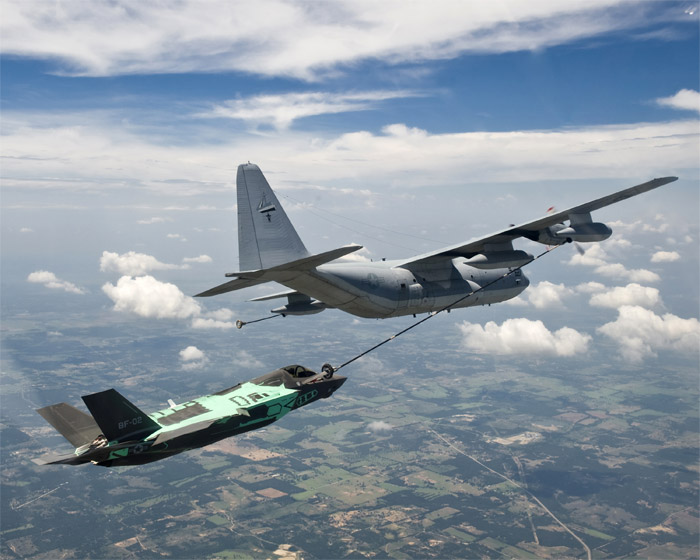
During Thursday’s flight, the F-35B designated BF-2 (the second STOVL flight test aircraft), began a series of tests in which fuel is uploaded into the aircraft at 10,000, 15,000 and 20,000 feet, at speeds ranging from 200 to 250 knots. The pilot on the initial F-35B aerial refueling flight was U.S. Marine Corps Maj. Joseph T. “O.D.” Bachmann.
The refueling mission also marked the first time a Lockheed Martin KC-130J tanker has been used to refuel an F-35. Since deployment to Iraq in 2005 the KC-130J has offloaded more than 186 million pounds of fuel during combat operations. Previous refueling missions with the F-35A conventional takeoff and landing variant were accomplished with a KC-135 tanker. To date, the first F-35A has received approximately 110,000 pounds of fuel during aerial refuelings.
Probe-and-drogue refueling employs a flexible hose that trails from the tanker aircraft. The basketlike drogue at the end of the hose connects to the receiving aircraft’s probe, which, in the case of the F-35, resides on the right side of the forward fuselage and retracts when not in use. The U.S. Navy, Marine Corps and the air forces of many other countries use the probe/drogue system, while the U.S. Air Force refuels its aircraft via a rigid flying boom that inserts into a receptacle on the receiving airplane.
The Lockheed Martin F-35 and F-22 are the world’s only 5th generation fighters, uniquely characterized by a combination of advanced stealth with supersonic speed and high agility, sensor fusion, network-enabled capabilities and advanced sustainment. The three F-35 variants are derived from a common design, are being developed together and will use the same sustainment infrastructure worldwide, bringing economies of commonality and scale.
Lockheed Martin is developing the F-35 with its principal industrial partners, Northrop Grumman and BAE Systems. Two separate, interchangeable F-35 engines are under development: the Pratt & Whitney F135 and the GE Rolls-Royce Fighter Engine Team F136.
Source: Lockheed Martin
Photo: Lockheed Martin
First C-5M Super Galaxy Delivered
Lockheed Martin today delivered the first fully modernized C-5M Super Galaxy to the U.S. Air Force.
The aircraft is the first of three developmental test C-5M aircraft to be delivered, with the other two to be delivered to Dover AFB, Del., in February 2009. Current Air Force plans call for Lockheed Martin to deliver 52 modernized C-5Ms.
“The C-5 fleet is now beginning to realize its full operational potential as we begin fielding both Avionics Modernization Program and Reliability Enhancement and Re-engining Program enhanced C-5s for the Air Force,†said Lorraine Martin, vice president of the C-5 Program at Lockheed Martin. “The combined U.S. Air Force and Lockheed Martin team can take great pride in its success, which is keeping this national strategic airlift asset viable for decades to come.â€
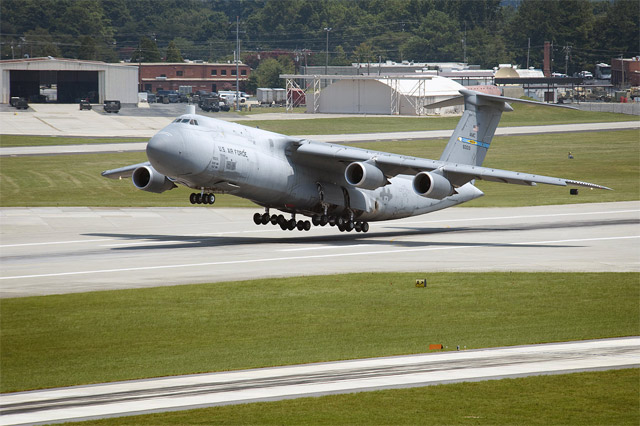
The C-5M Super Galaxy is the product of a two-phase modernization effort. The Avionics Modernization Program (AMP) provides a state-of-the-art glass cockpit and a digital backbone to support the Reliability Enhancement and Re-engining Program (RERP) modifications. 46 C-5 aircraft have completed the AMP modifications. The aircraft already returned to the fleet have logged more than 45,000 hours with the new systems, including many hours flown in support of Operation Iraqi Freedom.
RERP is the second phase of the modernization effort, which adds new GE CF6-80C2 commercial engines (military designation F138-GE-100) and 70 other enhancements or replacements of major components and subsystems. The additional 10,000 lbs of thrust per propulsion system creates 40,000 lbs of additional thrust across the platform, significantly improving operational performance. This comprehensive modernization program improves the fleet mission-capable rate (aircraft availability) and the overall reliability and maintainability of the aircraft while reducing total ownership costs.
The C-5 has been the backbone of strategic airlift in every engagement since it entered service. It is the only aircraft capable of carrying 100 percent of certified air-transportable cargo, with a dedicated passenger compartment enabling commanders to have troops and their equipment arrive in an area of operation simultaneously. The C-5 can carry twice the cargo of other strategic airlift systems. With more than 70 percent of its structural service life remaining, Lockheed Martin is committed to sustaining the C-5 fleet throughout its lifecycle. The C-5M Super Galaxy will continue to be a force enabler through 2040.
Source: Lockheed Martin
Photo: Lockheed Martin

